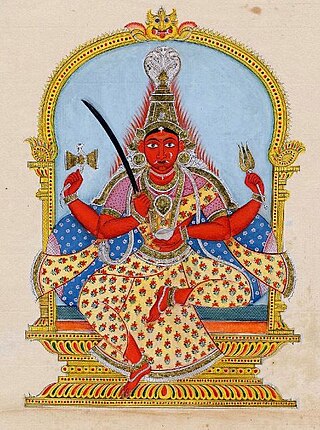
Mariamman, often abbreviated to Amman, is a Hindu goddess of weather, predominantly venerated in the rural areas of South India. Her festivals are held during the late summer/early autumn season of Ādi throughout Tamil Nadu and the Deccan region, the largest being the Ādi Thiruviḻa. Her worship mainly focuses on bringing rains and curing diseases like cholera, smallpox, and chicken pox. Mariamman is worshipped in accordance with local traditions such as Pidari or the Gramadevatai. She is considered as a guardian deity by many South Indian village-dwellers. She is also the regional form of hindu goddess Parvati. Her consort is lord Shiva. At samayapuram, she is the sister of Ranganathaswamy. She is also worshipped in Karnataka as Marikambe, who is a manifestation of Adi-Parashakti or Mahadevi.
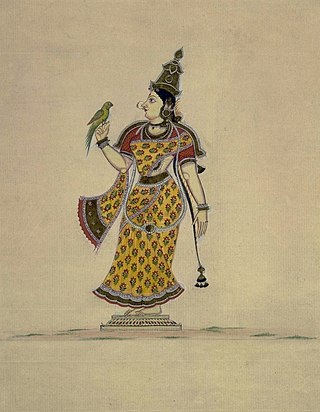
Meenakshi is a Hindu goddess. She is the tutelary deity of Madurai and is considered a form of the goddess Parvati. She is the divine consort of Sundareśvarar, a form of Shiva. She finds mention in literature as the queen of the ancient Madurai-based Pandya kingdom, and is later deified. The goddess is also extolled by Adi Shankara as Shri Vidya.
Arunthathiyar is a scheduled caste community mostly found in the Indian state of Tamil Nadu. The term has two distinct usages: for the purposes of the state government's positive discrimination program, in 2009 it was designated an umbrella term for the Arunthatiyar, Chakkiliyar (Sakkiliyar), Madari, Madiga, Pagadai, Thoti and Adi Andhra communities with a total population of 2,150,285, accounting for 14.89% of the Scheduled Caste population according to the 2011 Census of India. While the Office of the Registrar-General, which administers the census of India, does not recognize all of those communities as one.

The Nellaiappar Temple is a Hindu temple dedicated to the deity Shiva, located in Tirunelveli, a city in the South Indian state of Tamil Nadu. Shiva is worshipped as Nellaiappar represented by the lingam and his consort Parvati is depicted as Kanthimathi Amman. The deity Vishnu is also worshipped here, having witnessed their wedding according to legend. Hence, this temple is regarded as an abhimana kshetram of Vaishnavism. The temple is located on the northern banks of Thamirabarani River in Tirunelveli district. The presiding deity is revered in the 7th century Tamil Saiva canonical work, the Tevaram, written by Tamil saint poets known as the nayanmars and classified as Paadal Petra Sthalam.

Arulmigu Meenakshi Sundareswarar Temple, also known as Arulmigu Meenakshi Amman Thirukkovil, is a historic Hindu temple located on the southern bank of the Vaigai River in the temple city of Madurai, Tamil Nadu, India. It is dedicated to the goddess Meenakshi Amman, a form of Parvati, and her consort, Sundareshwarar, a form of Shiva. The temple is at the centre of the ancient temple city of Madurai mentioned in the Tamil Sangam literature, with the goddess temple mentioned in 6th-century CE texts. This temple is one of the Paadal Petra Sthalams, which are 275 temples of Shiva that are revered in the verses of Tamil Saiva Nayanars of the 6th-9th century CE.

The Srivilliputhur Andal Temple in Srivilliputhur, a town in Virudhunagar district in the South Indian state of Tamil Nadu, It is one of the 108 Divya Desams dedicated to Vishnu, who is worshipped as Vatapatrasayi and his consort Lakshmi as Andal. It is believed to be the birthplace of two of the Alvars, namely Periyalvar and his foster-daughter, Andal. The temple is located 80 km from Madurai. Constructed in the Ancient Indian style of architecture, the temple is glorified in the Nalayira Divya Prabandham, the early medieval Tamil canon of the Alvar saints from the 6th–9th centuries CE.

Kalaiyar Kovil is a Town and a Panchayat Union in Sivaganga District, Tamil Nadu, India. Kalayarkoil is a Taluk in Sivaganga District of Tamil Nadu State, India. It is located 18 km east from District headquarters Sivaganga.466 km from State capital Chennai.
Sacchidananda Bharati I , was a Hindu sant and religious leader of the 17th century. He was the Jagadguru of the Hindu matha Sringeri Sharada Peetham from 1623 to 1663, and is believed to have saved it from attack by spiritual means.

The Mutharamman Temple is located in Kulasekharapatnam near Thiruchendur in the Thoothukudi district, Tamil Nadu. It is 300 years old. The temple is situated at a distance of 14 km. from Tiruchendur.
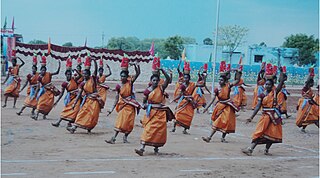
Karakattam, or Karagam Puja in the Caribbean, is an ancient folk dance of Tamil Nadu performed in praise of the rain goddess Mariamman. The ancient Tamil epic says that this type of dance derived from Bharatham and a mixture of multiple forms of Tamil dance forms like Bharatanatyam postures and mudras. The offering of this dance is to the goddess to bless rain. The dance accompanies songs like folk Carnatic (Amrithavarshini).

The Meenakshi Tirukalyanam festival, also known as Chithirai Tiruviḻa or Meenakshi Kalyanam, is an annual Tamil Hindu celebration in the city of Madurai during the month of April. The festival, celebrated during the Tamil month of Chithirai, is associated with the Meenakshi Temple, dedicated to the goddess Meenakshi, a form of Parvati and her consort Sundareshvara, a form of Shiva.
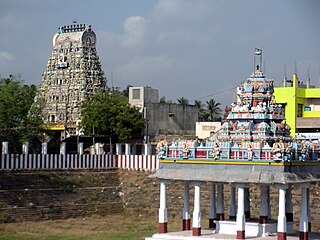
Thyagaraja Temple is a Hindu temple dedicated to Hindu god Shiva. It is located in Tiruvottiyur in the northern part of Chennai, Tamil Nadu, India. The temple is revered by the Tevaram hymns of Saiva nayanars, the 7th century Tamil saint poets and classified as Paadal Petra Sthalam. All the Three of Thevaram Moovar has rendered Thevaram songs in this temple. The temple is closely associated with the saint poet Sundarar and Pattinathar. The temple has been in vogue from the Pallava times of the 7th century and widely expanded by Chola kings during the 11th century. The temple has a seven tiered gateway tower, a tank, with the overall temple area covering 1 acre. The temple is administered by the Hindu Religious and Endowment Board of the Government of Tamil Nadu. The temple draws parallel with the Thygaraja temple in Tiruvarur as both the temples were expanded by Rajendra Chola I and both have the same dance poses of Shiva. The temple is one of the 51 Sakthi Peetams in the country.
The Meenkulathi Temple is located in Pallassena, a village in southern India.

Madurai Veeran (transl. The Warrior of Madurai) is a 1956 Indian Tamil-language historical action film directed by D. Yoganand, written by Kannadasan, and produced by Lena Chettiar. Based on the folklore legend turned deity of the same name, it stars M. G. Ramachandran as the eponymous character, with P. Bhanumathi and Padmini playing his love interests. T. S. Balaiah, N. S. Krishnan and T. A. Mathuram play supporting roles.
Madurapuram is a small village in India that lies on the banks of the Vaigai River and on the National Highway 49 that connects Madurai with Rameshwaram. The village is situated 18 kilometres (11 mi) from Madurai. Though Madapuram is near Madurai it is within Sivagangai district. The famous Madurapuram Badhrakali amman and ayyanar temple is situated at this place. Today this temple is managed by HR & CE ministry of Government of Tamil Nadu.

Vandiyur Mariamman Teppakulam is a temple tank located near to Vandiyur Mariamman Temple and situated at a distance of about 5 km from the Meenakshi Amman Temple. Literally, Teppakulam means temple pond mainly used for devotional festivals.
Nilakantha Diksita was a minister in the 17th century court of King Thirumalai Nayak of Madurai. He composed several poems and literary works, including Ananda Sagara Stavam.
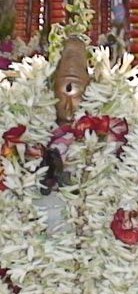
Murthi Nayanar, also spelt as Murthy Nayanar, Moorthy Nayanar and Murti Nayanar and also known as Murtti, is a Nayanar saint, venerated in the Hindu sect of Shaivism. He is generally counted as the fifteenth in the list of 63 Nayanars.
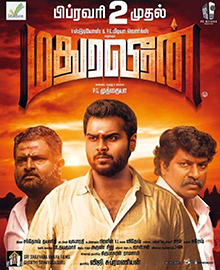
Madura Veeran is a 2018 Indian Tamil-language action drama film written and directed by cinematographer P. G. Muthiah. Viji Subramaniam produced the film along with the director, under the banners of V Studios and PG Media Works. Shanmuga Pandian and Meenakshi play the lead roles, while Samuthirakani, Vela Ramamoorthy and Mime Gopi amongst others play supporting roles in the film. Santhosh Dhayanidhi was selected to compose the music for the film. The film's plot narrates the issues on jallikattu and the politics associated with, favouring the tradition rather than the proposed ban. The film released across Tamil Nadu on 2 February 2018 with mixed reviews.
Kanchanamalai (Tamil:காஞ்சனமலை) was legendary queen consort of Madurai and Korkai and also empress of the Pandya dynasty. She ruled Madurai alongside her husband, King Malayadhvaja Pandya. She was also the mother of Meenakshi. Kanchanamalai is believed to be the reincarnation of Vidyavati.














